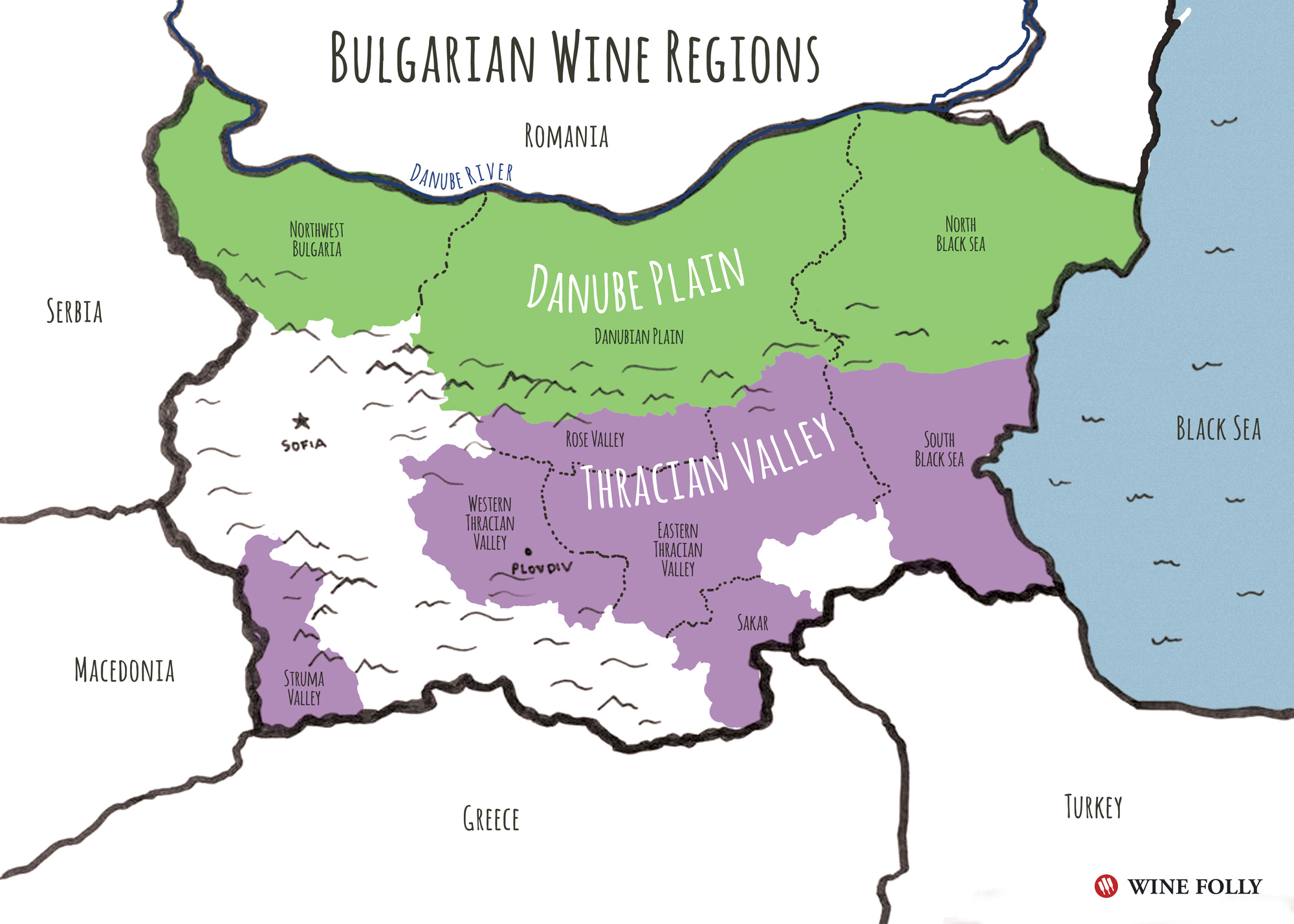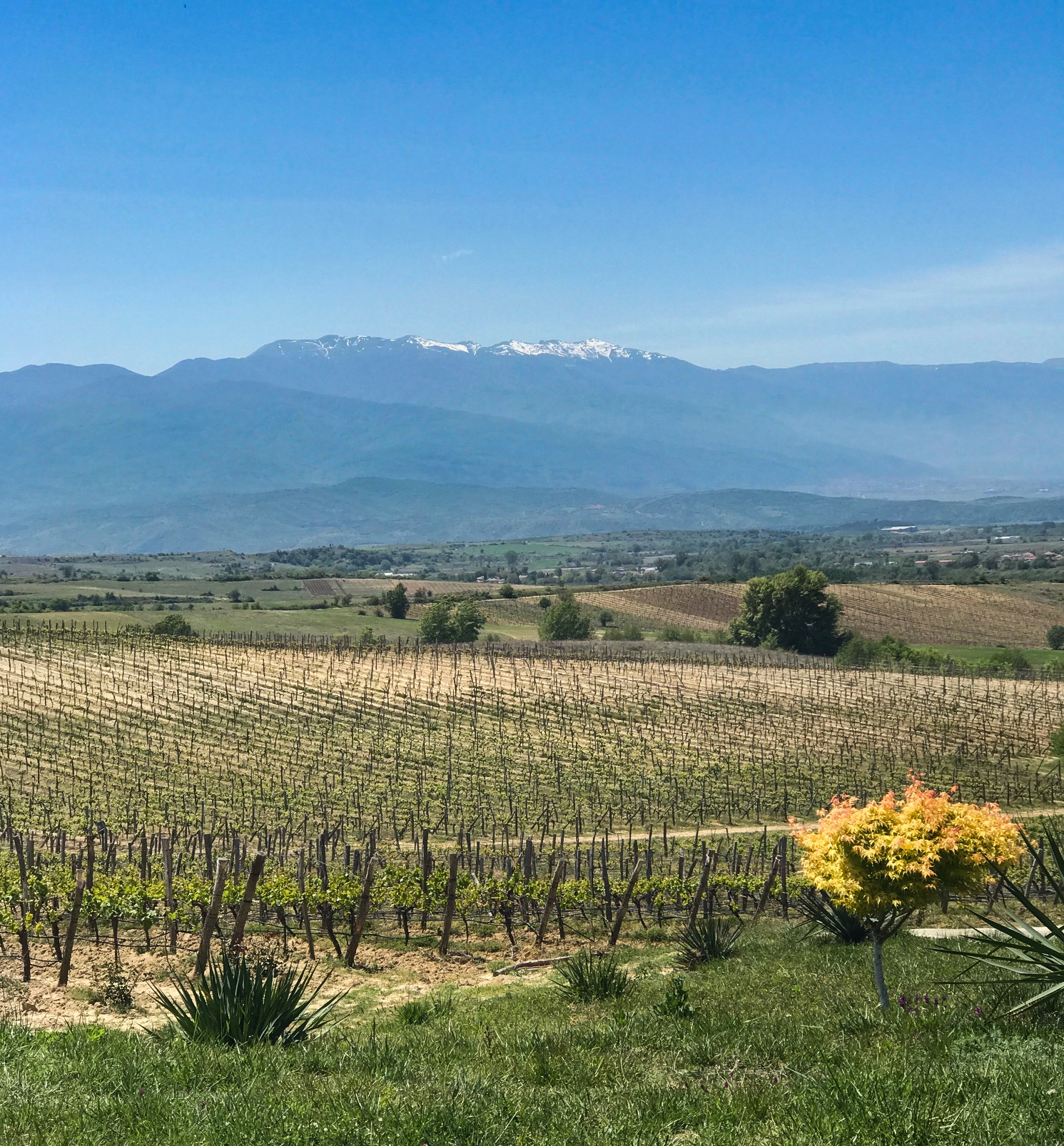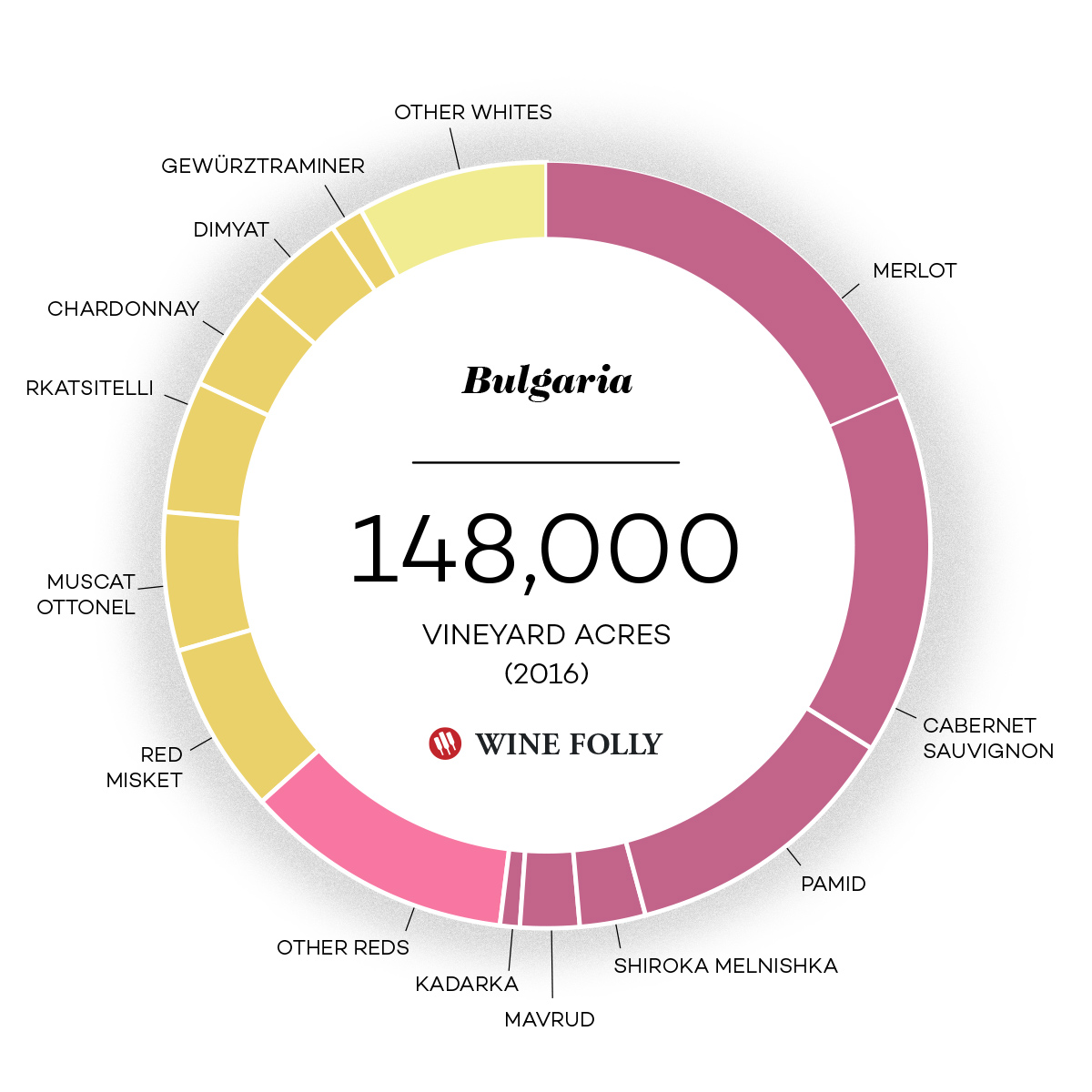Pure fruit-driven red wines with a touch of tartness.
Unless you grew up in Russia in the 1970s and 80s, there’s a pretty good chance that you’ve never tried Bulgarian wine. It was during this time that Bulgaria (a country smaller than New York State) became the 4th largest wine producer in the world. Of course, westerners barely saw a drop. Ninety percent went to the Soviet Union and the Bulgarian wine industry was a state-run, socialist, wine-growing monopoly. No joke!
Then, things crumbled apart in 1989 when the socialist regime fell. The transition of land ownership and wineries back to the private sector meant quality suffered greatly until about 2000 (check out SAPARD). It’s been a long, slow, hard road for the last 30 odd years but…
Bulgarian wine is back!
Since you’re likely to see more Bulgarian wine in coming years (especially if you’re on the East Coast or Europe), this introduction to the wines of Bulgaria will give you a leg up on what to look for.

Just so you know, not only does Bulgaria offer exceptional wine quality for jaw-dropping value, there are many unique varieties that you won’t find anywhere else.
“After a recent trip to Bulgaria, I was blown away by the wines in general. I thought that the international varietal [wines] were spot-on and tasted “as they should.” I was also very pleased with the minerality and acidity.”
Hillary Zio, 10-year veteran wine writer and educator in New York City.
13 Wines To Explore From Bulgaria
Red wines dominate Bulgaria. What will surprise you is the high number of recognizable wine varieties, including Cabernet Sauvignon, Merlot, Sauvignon Blanc, and Chardonnay. These international varieties were actually mass planted during the socialist regime and now make up about 70% of the plantings. Fortunately, several local varieties are being reintroduced by passionate producers who recall a historic period after World War I when independent wineries championed the country’s native grapes.
Red Wines
-

Mavrud An indigenous variety that exudes rich, crushed cherry and chocolate-like flavors on a medium body. To a newcomer, these wines have a similar profile to a lightly-oaked Malbec, along with the same striking magenta-tinged rim. Quality is still somewhat variable, so read tasting notes before buying.
-

Melnik 55 or “early Melnik” is a genetic-cross between the local Broad-leafed Melnik and French Valdeguié. Melnik 55 and Broad-leaf Melnik grow almost exclusively in Struma Valley in the Southwestern part of Bulgaria. This mountainous area delivers elegant and peppery reds with flavors of strawberry, blackberry, black pepper, mesquite and soy sauce. Blended wines have bold tannins with bitterness similar to green tea powder. Pure, single-varietal Early Melnik are much lighter in body, similar to Gamay from Beaujolais.
-

Rubin A successful cross between Nebbiolo and Syrah created at the end of the 1950s. The hybrid is often described as a man wearing a suit and cowboy boots because of it’s finessed herbal, plummy fruit matched with somewhat rigorous tannins. For this reason you’ll often find Rubin blended with Mavrud to add structure, color and body. Flavors range from sweet strawberry to blackberry, with subtle coffee and espresso-like notes. The wine shows it’s best as it ages and the fruit flavors blossom as the tannin softens much like an aged Italian Nebbiolo.
-

Gamza (aka Kadarka) An old Eastern European variety that’s likely origin is from somewhere in the Balkans and thus it prefers the cooler climates in Northwest Bulgaria. Tart berry flavors with a savory, herbal profile and a touch of black pepper and baking spice not unlike an Italian Barbera or Oregon Pinot Noir. Because of it’s light body and high aromatics Gamza is best served in a Burgundy glass.
- Cabernet Sauvignon and Merlot Pure black cherry fruits with subtle tobacco leaf, violet, and vanilla aromas. Wines often have a touch of tartness which lends to a lighter, more elegant, medium body. Producers often blend Cabernet with Syrah and Mavrud.
- Cabernet Franc A grape that grows superbly in Bulgaria’s moderate climate but is still very much up-and-coming (hard to find and somewhat variable). This pure varietal wine delivers cassis, red paprika, black currant, capsicum, dust, mint, and cherry. Yum.
- Pinot Noir In the Danube Plains there are several microclimates with limestone soils that show incredible potential for Pinot Noir. Imagine flavors of pomegranate, dried violet, hibiscus, and cocoa powder with fine grained tannins and an earthy, mushroom-like minerality. At well under $20 a bottle, these wines over deliver.
“After tasting a selection of top Bulgarian wines I was intrigued by the native varieties of Mavrud, Melnik 55 and Rubin. What was interesting was a persisting salinity and savory quality present in all the wines, especially the whites.”
Madeline Puckette, Wine Folly
White Wines
-

Red Misket (aka Misket) The “red” in the name refers to the pinkish color of the grape. This is a dry, somewhat saline, aromatic white wine that could be imagined like a dry Moscato, with flavors of mandarin orange, rose water, lime and thai basil. The finish can be somewhat salty, with lingering flavors of dried pineapple or mango.
-

Dimyat Likely to be of Bulgarian origin, Dimyat is actually related to Chardonnay and Aligote by the ancestor grape, Gouais Blanc. Wines will tickle your taste buds with acidity and flavors similar in style to Aligote, including subtle notes of apple, citrus, and apple blossom.
-

Tamianka (aka Muscat Blanc) It carries a different name due to the distinctive aroma of incense. This grape offers quite promising results, even in Southern regions of Bulgaria, but the north offers an element of freshness and elegance. Off-dry styles are typical and common. The wines from Tamianka display layered aromas of ripe fruit, flowers and spices. Single vineyard Tamianka wine from the South Sakar wine region (an area also good for Syrah and Merlot) has served as a flagship wine for the aromatic whites of the country.
- Chardonnay Bulgarian Chardonnay is often made in unoaked styles which are fresh and fruity with notes of apple, pineapple, and starfruit, with good acidity and subtle gravelly minerality. It’s possible to find delicious oak-aged versions, although they are much harder to find.
- Sauvignon Blanc A new variety trend in Bulgaria, with the oldest Sauvignon Blanc plantings dating back to 2000. Wines have more subtle aromatics with more herbal flavors of lime peel, pea shoot, white pepper and fresh cut grass. On the palate, there is a nice mid-weight body that finishes somewhat salty and savory with notes of dried grass and sea shells.
-
Rikat (aka Rkatsitelli “Kat-seh-telly”) This is of Eastern Europe’s top white varieties and the most planted white grape in Bulgaria. Still, Rikat is rarely used as a single varietal wine, you’ll mostly find it used as a neutral grape used almost like Sémillon in the white Bordeaux blend to round out flavors.

Bulgarian Wine Facts
- In 2016, Bulgaria reported around 148,000 acres (60.000 hectares) of vineyards with a production size placing it 22nd in the world.
- The country receives around 2,200 to 2,500 sunlight hours per year, which is similar to Northern Italy, Southern France, and Northern Spain and Portugal (all areas with important red wine production).
- Since August 16th, 2005, Bulgaria has two official wine growing regions: Danube Plain and Thracian Valley. Both are PGIs (Protected Geographic Indication).
- Within the country, about 75% of the vineyards in Bulgaria are found in the Thracian Valley PGI.
- Cabernet Sauvignon and Merlot make up 31% of the vineyard area and are very important varieties because they act as proof of quality of Bulgarian wine and a bridge into other varieties.
- Temperatures in the summer are moderated by the Black Sea, allowing for a mild summer that maintains acidity in varieties.
- Vineyard yields in Bulgaria are surprisingly low (an average of 4.3 tons/acre compared to US average of 18 tons/acre), suggesting a quality focused future for Bulgarian wine.
- If you talk to people within the Bulgarian wine industry they believe the country will be eventually separated into 9 total regions: Danubian plain, North Black Sea Coast, South Black Sea Coast, East Thracian Valley, West Thracian Valley, Rose Valley, Sakar and Struma River Valley. This is the eventual future of Bulgarian wine quality.
Sources
Special thanks and expert credit goes to Marin Atanasov and Hillary Zio who provided in-depth knowledge, writing, additional tasting notes, photos and more to help with the creation of this article.
Check out Christy Canterbury’s recent Bulgarian wine ratings.
Check Wine Enthusiast Mag for recent reviews and ratings of internationally exported Bulgarian wines.
Another article from the Washington Post about the history and coming of Bulgarian wine.
